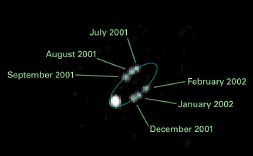

|
Документ взят из кэша поисковой машины. Адрес
оригинального документа
: http://www.stsci.edu/~inr/thisweek1/2008/thisweek196.html
Дата изменения: Tue Jul 22 00:29:23 2008 Дата индексирования: Sat Sep 6 06:50:40 2008 Кодировка: |


| Program Number | Principal Investigator | Program Title | Links |
| 11107 | Timothy M. Heckman, The Johns Hopkins University | Imaging of Local Lyman Break Galaxy Analogs: New Clues to Galaxy Formation in the Early Universe | Abstract |
| 11113 | Keith S. Noll, Space Telescope Science Institute | Binaries in the Kuiper Belt: Probes of Solar System Formation and Evolution | Abstract |
| 11122 | Bruce Balick, University of Washington | Expanding PNe: Distances and Hydro Models | Abstract |
| 11130 | Luis Ho, Carnegie Institution of Washington | AGNs with Intermediate-mass Black Holes: Testing the Black Hole-Bulge Paradigm, Part II | Abstract |
| 11151 | Gregory J. Herczeg, California Institute of Technology | Evaluating the Role of Photoevaporation of Protoplanetary Disk Dispersal | Abstract |
| 11156 | Kathy Rages, SETI Institute | Monitoring Active Atmospheres on Uranus and Neptune | Abstract |
| 11158 | R. Michael Rich, University of California - Los Angeles | HST Imaging of UV emission in Quiescent Early-type Galaxies | Abstract |
| 11172 | Arlin Crotts, Columbia University in the City of New York | Defining Classes of Long Period Variable Stars in M31 | Abstract |
| 11196 | Aaron S. Evans, State University of New York at Stony Brook | An Ultraviolet Survey of Luminous Infrared Galaxies in the Local Universe | Abstract |
| 11197 | Peter Garnavich, University of Notre Dame | Sweeping Away the Dust: Reliable Dark Energy with an Infrared Hubble Diagram | Abstract |
| 11202 | Leon Koopmans, Kapteyn Astronomical Institute | The Structure of Early-type Galaxies: 0.1-100 Effective Radii | Abstract |
| 11206 | Kai G. Noeske, University of California - Santa Cruz | At the cradle of the Milky Way: Formation of the most massive field disk galaxies at z>1 | Abstract |
| 11212 | Douglas R. Gies, Georgia State University Research Foundation | Filling the Period Gap for Massive Binaries | Abstract |
| 11219 | Alessandro Capetti, Osservatorio Astronomico di Torino | Active Galactic Nuclei in nearby galaxies: a new view of the origin of the radio-loud radio-quiet dichotomy? | Abstract |
| 11235 | Jason A. Surace, California Institute of Technology | HST NICMOS Survey of the Nuclear Regions of Luminous Infrared Galaxies in the Local Universe | Abstract |
| 11237 | Lutz Wisotzki, Astrophysikalisches Institut Potsdam | The origin of the break in the AGN luminosity function | Abstract |
| 11545 | Ben Davies, Rochester Institute of Technology | A NICMOS survey of newly-discovered young massive clusters | Abstract |
| 11547 | Dimitrios Gouliermis, Max-Planck-Institut fur Astronomie, Heidelberg | Characterizing Pre-Main Sequence Populations in Stellar Associations of the Large Magellanic Cloud | Abstract |
| 11800 | Keith Noll, Space Telescope Science Institute | Hubble Heritage imaging of NGC 3324 in the Carina Nebula | Abstract |
GO 11113: Binaries in the Kuiper Belt: Probes of Solar System Formation and Evolution
 A composite of HST images of the Kuiper Belt binary, WW31
A composite of HST images of the Kuiper Belt binary, WW31
|
The Kuiper Belt consists of icy planetoids that orbit the Sun within a broad band stretching from Neptune's orbit (~30 AU) to distance sof ~50 AU from the Sun (see David Jewitt's Kuiper Belt page for details). Over 500 KBOs are currently known out of a population of perhaps 70,000 objects with diameters exceeding 100 km. Approximately 2% of the known KBOs are binary (including Pluto, one of the largest known KBOs, regardless of whether one considers it a planet or not). This is a surprisingly high fraction, given the difficulties involved in forming such systems and the relative ease with which they can be disrupted. It remains unclear whether these systems formed from single KBOs (through collisions or 3-body interactions) as the Kuiper Belt and the Solar System have evolved, or whether they represent the final tail of an initial (much larger) population of primordial binaries. This proposal will use WFPC2 imaging of known KBOs to identify new binary systems. |
GO 11172: Defining Classes of Long Period Variable Stars in M31
GO 11235: HST NICMOS Survey of the Nuclear Regions of Luminous Infrared Galaxies in the Local Universe